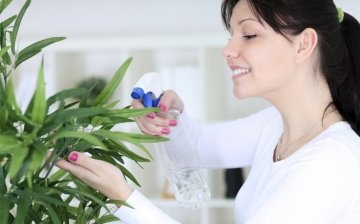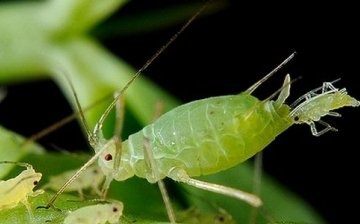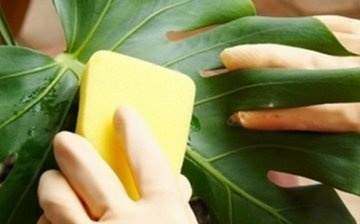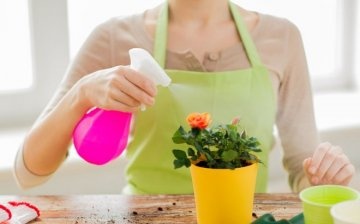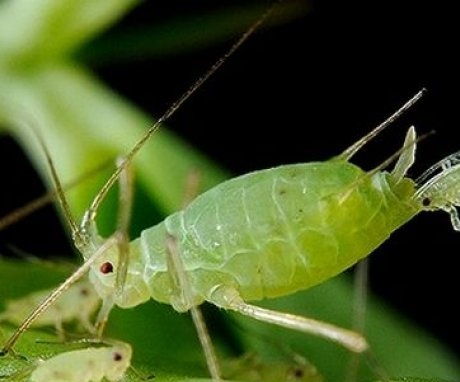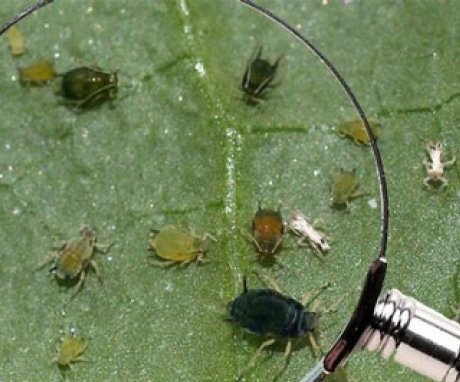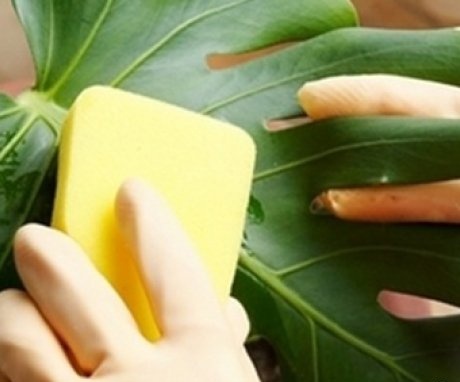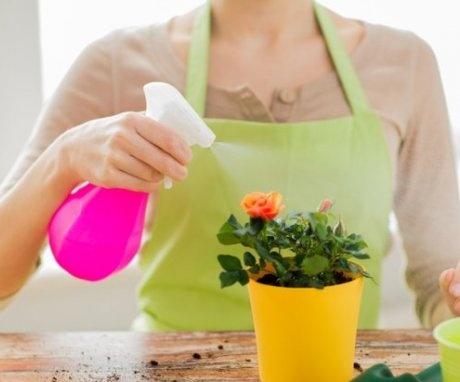Tips for flower growers: how to get rid of aphids on indoor flowers
Aphids able to destroy ornamental plants in a matter of days. They parasitize not only in the garden, but also at home. The trouble is that pests multiply quickly and the grower needs to find a female that has entered the house in time. Getting rid of aphids is difficult. The main thing is not to give up and use different methods of dealing with the pest, otherwise the plant will quickly die.
Content:
- How do aphids appear at home?
- What harm do aphids do to plants?
- Small colonies - fighting by folk methods
- Large colonies - insecticide control
- Prevention is the best way to fight
How do aphids appear at home?
Many beginner growers are surprised that aphids appear on their favorite flowers. Where did it come from? Many have developed a stereotype - aphids can only parasitize on the street, the pest does not threaten domestic plants. But this is far from the case. At a certain moment of development, the female aphid begins to "travel", fly in search of a new plant in order to lay eggs. Young offspring need food in the form of a plant that has not yet been eaten. Often, females enter the house through open windows or balcony doors. She finds a plant and lays eggs on it. So a colony of aphids appears on domestic plants.
Another way for a pest to enter a home is to buy a new plant in a store.
Often the larvae or the aphids themselves end up in the soil or on the leaves of the flower. The buyer, as a rule, does not notice the "guests" and takes the purchased green pet home. Later, a small colony of aphids is found on the plant. Therefore, always inspect the flower carefully before buying it. Aphids will parasitize not only on this plant, but also on other home flowers. It costs nothing for a pest to occupy a green home garden.
Be careful when buying plants. In the summer, inspect home flowers every day in order to find the eggs on the leaves in time, which were laid by the female who entered the house.
What harm do aphids do to plants?
The pest causes colossal damage to crops. The parasite sucks out the sap of the plant with the help of the proboscis, with which it pierces the tissue. If the colony is large, the flower quickly fades, turns yellow and dries. Eventually, the plant dies. Aphids can be compared to vampires who suck the "blood" of a flower, which will certainly lead to the "death" of a green pet.
The pest, in addition to sucking out the juice, spreads various fungal diseases.
So the plant can begin to hurt even from an additional ailment. In this case, it will be even more difficult to save him. If aphids appear on one flower, it means that they will definitely move to another, neighboring one. The flower grower does not even have time to look back, as the parasites are already doing their black business on all domestic plants. Therefore, you need to get rid of pests immediately, you cannot start a defeat.
Small colonies - fighting by folk methods
With the help of folk remedies, it is more expedient to deal with the pest in the early stages of the defeat - small colonies that can be seen on one or two leaves. It is good if the grower was able to find just laid eggs.
They just need to be crushed and that's it, the development of parasites will not happen, provided that the female also dies. However, it is quite difficult to "catch" the pest at the stage of laying eggs. Therefore, we will talk about small colonies of newborn parasites, of which there are not so many.
Folk remedies against the pest:
- Tobacco "medicine". Any gardener knows that at the first sign of aphids, it is necessary to treat the plant with a solution of tobacco or tobacco dust. At the first stages, the leaves of the plant still do not curl or turn yellow, but traces of the aphid's actions are visible - the greens wither, the pest is visible on the back of the leaves and on the twigs. At this stage, the use of tobacco will be effective. To prepare the solution, you need to collect fresh tobacco leaves and fill them with water. Let it brew for a day. Then the infusion must be brought to a boil and boiled over low heat for an hour. When the broth has cooled, add some soap shavings to it. Proportions - 1 part tobacco to 10 parts water, 30-40 grams of soap shavings. Instead of fresh raw materials, you can take tobacco dust or dry tobacco leaves. Spray the plant every three days until the aphids disappear completely.
- Alcohol and laundry soap. If the grower managed to find eggs or a small amount of parasites on one leaf, you need to blot a cotton pad in rubbing alcohol (95%) and wipe the leaf. There will be no burn, as alcohol evaporates very quickly. This method is relevant only with a small number of aphids or when a clutch of eggs is found.
- Many growers praise the simple but effective method of dealing with ordinary laundry soap. Dissolve the shavings in a bucket of water and wipe the leaves with soapy water. The proportions are 50 grams per 10 liters. Treat the plant every three to four days until the aphids disappear completely.
- Onions, garlic + soap. The ingredients for this infusion are found in every home. Take a middle head Luke and garlic, grind them in a meat grinder and fill with water (10 liters). Insist for a day. Then add 30-40 grams of soap shavings to the resulting infusion. Mix thoroughly. Treat the plant every five days until the aphids are gone.
As practice shows, folk methods do not cope well with large colonies. In this case, "heavy artillery" - chemistry is used.
Large colonies - insecticide control
If the plant is already dying, the leaves have turned yellow, twisted and the flower is covered with a "cap" of parasites, it can be saved only with the help of chemicals. This must be done urgently, otherwise the culture will perish. The interval between sprays is usually seven days, but this depends on the type of chemical.
The treatment must be carried out several times, since the larvae of the parasite do not lend themselves to chemicals.
You have to wait for them to move to the next stage of development, this happens just on the seventh day. In this regard, several treatments are carried out.
Such drugs as Fitoverm and Actellika have proven themselves well. The drugs belong to a safe class and do not require special precautions when applying, only a gauze mask on the face. If your hands are sensitive, gloves can be worn for greater safety. Cover the soil before applying the prepared solution. This can be done using regular film. Dilute the drugs according to the instructions on the package or in a special insert.
To combat the pest, "Intavir", "Iskra" or "Karbofos" are widely used. Before purchasing any drug, check it on the list of approved insecticides, otherwise poisoning may occur. It is very important to use chemicals with caution, even if they are biological.
Prevention is the best way to fight
Pest prevention is very simple. In the period from late February to autumn, a number of preventive measures should be taken.They include the sprinkling procedure, airing the rooms, maintaining the optimal level of humidity in the room. Bathing flowers in the shower helps to wash away the pests that have appeared, when the grower has not yet noticed them. Aphids are quite easy to knock down with a stream of water.
Pests are more likely to appear in rooms with dry air, so it is important to monitor the humidity.
When transplanting a plant, be sure to carry out the procedure disinfection... Spill over the soil with a weak solution of potassium permanganate. After three to four weeks, you can plant a flower. When buying a plant from a store or garden center, do not put the pot together with other flowers at once. Quarantine it and observe the culture. Usually, after a week, other aphids will find themselves. As a preventive measure, many growers sprinkle flowers with tobacco dust every two weeks from February to September. Even if aphids do appear, they will quickly die. For preventive purposes, many grow fragrant pelargonium. This plant repels parasites.
All these simple activities will help protect your home garden from aphids, as well as from spider mites, which also often visit your home greenhouse. Inspect the flowers more often, take measures in time, which will be the key to healthy and lush flowering of your favorite plants.
More information can be found in the video:



